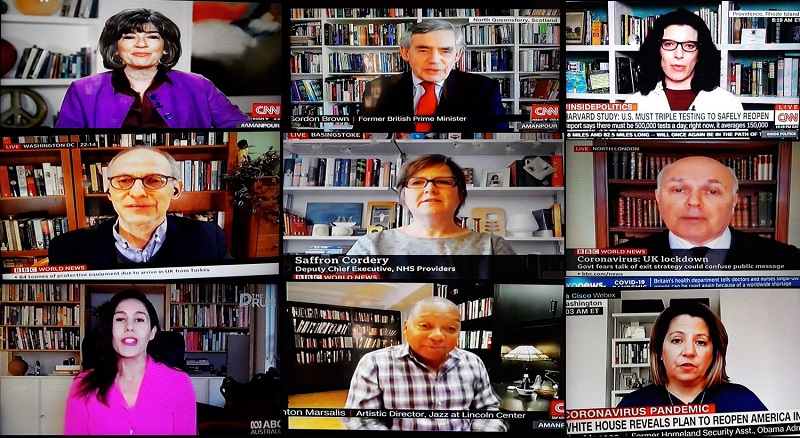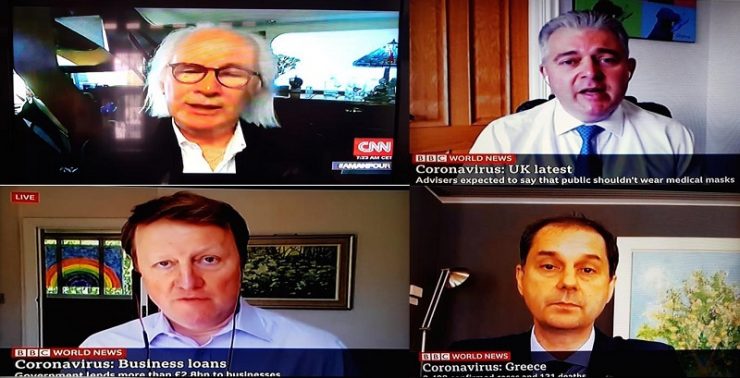SINCE this coronavirus pandemic time, to keep myself up-to-date with the news, I’ve been following global news from channel to channel, such as CNN International, BBC International, Aljazeera (English). Euro News, and DW (English).
We can learn so much from how the professional presenters and news anchors interact with their interviewees, and how these speakers present them-selves in front of the video camera for live discussions.
Live Chat or Discussion is The Norm
With the coronavirus (COVID-19) pandemic, where you are obliged to work from home, or just simply stay at home, most of us are so lucky that the technology helps us to stay closely connected (even connected ‘live), with either your loved ones, or business relations, even when you are far apart from each other.
Rather than sending text or email messages, during the social distancing period, more people prefer to communicate using audio-visual for live discussion or for live chat. Audio-visual is the most powerful means of communications as you can clearly express how you communicate, using your emotions, moods, and professionalism. Audio-visual communication helps close distance’s gaps between you and your audience.
Audio-Visual Camera is Your Best Friend
We have come to realize how much we already depend so much on our built-in camera in your mobile phone or laptop or desktop, as well as on the stand-alone cameras or video cameras.
It has become part of our everyday activities to communicate using our mobile phones, notebooks/tabs, laptops/desktops and perhaps less often in using cameras or video cameras. These gadgets have become necessary items to have in our lives, as we also store our personal data in them. Basically your life is in these gadgets!
And so, your video camera and a speaker have become your best friend. You will need them to have an effective live meeting with the person/s you want to talk to, whether a leisure live talk or a formal live meeting or even a live classroom meeting. Or may be, as a guest speaker, you’re invited to join a live meeting or live seminar and be asked to speak.
Your Appearance and Surrounding Space Matter
Since you’ll be doing the live chat or meeting or discussion from home, it is easy to let your guard down. Your being not caring enough on how you appear in front of the camera. You may look messy, because you have not had the haircut for sometime, the space where you hold the live communication is untidy, and so forth.
According to Claude Lelouch, “Appearance is valued too much in our society”. Why your appearance matters? During the video call, you are creating an image to your audience. Your audience has the time to observe your appearance, and your surrounding space, presented in one picture frame.
While you are talking, you are being observed the very details you present, from your face feature, your eye contact, your facial expression, any other body language like hand gestures, then the clothes you wear, the accessories, as well as the surrounding space used as your background.
So it is up to you, do you want create a good impression, do you want to respect your audience so that you’d put more efforts to wear decent attire and arrange your background in a more presentable way?

For a pleasantly presentable and impressive self-presentation for a video call, you need to prepare it in advance. Here are some of the tips for you to note:
1. Compose Your Self-Portrait
You are creating an image in the mind of the audience. Your audience is looking at a moving portrait of you. They have their own perception of you. Remember the saying “Beauty is in the eye of the beholder”?
Work within the limited space that the camera can cover, e.g. from head to half of your body. You’d appear like a portrait. So like in a portrait painting, you need to compose on how you want to appear.
2. Set the Mood
In setting the right mood, either you set for a professional appearance for a formal live discussion, or informal as it will be live chat with friends. If in formal setting, ensure you wear professional attire, with the background looking neat and professional as well.
If in informal, you’ll still need to look presentable, perhaps you choose other more relaxing space, like your living room. Remember no mess captured in the camera.
3. Use Books, Plants or Art Objects
I’ve noticed many speakers choose to have bookshelves as their background, some with a touch of a plant. Some have a painting or an art object as their background, which I find it very professional and interestingly tasteful.
In my case, apart from being a PR practitioner, I am also a lecturer (part-time), I run eLearning through online classes, I would put my formal clothes on, with a touch of make up, and use a corner of my house where I have bookshelves, and I use them as my background. As a lecturer, I want to look formal and proper in the eyes of my students.
4. Eye-to-Eye Level
Ensure that you have the same eye-level with your audience – it is more ethical this way. It will look very tiring from the audience’s part when you are looking down at them through the camera, as the audience will be looking up on you. Same with the other way round, if you are looking up at the camera, meaning you’re looking up at the audience, it will feel awkward for them to look down on you.
5. Give Distance Between You and the Camera
Another important thing to note is, for you not to be too close to the camera, as you’ll only look gigantic, because in most part of the screen only your face that covers it, and so you’ll scare off the audience.
So, to do your video calls properly whether formal or informal, you need to prepare your self-presentation and set the mood right. Always respect the person you’re going to talk to. How you present yourself matters, as you are creating an image to your audience. They will have a perception of you just from the very video call. Lastly, do it in a fun way, and enjoy doing it like it is your second nature! [by Ida Bayuni, Public Relations practitioner – based in Jakarta]
















